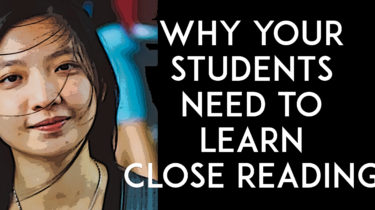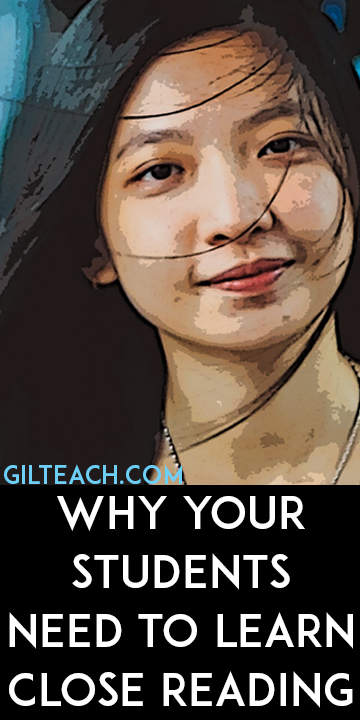6 Reasons Why Your Students Need Close Reading

When I think about my goals as a teacher, I think about how I want to empower my students to go out into the world and think for themselves. Creating independent, confident, life-long learners who aren’t afraid to try to new things is really the ultimate dream. But figuring out how best to spend the limited time that I have in class in order to achieve those dreams is not always easy. I have found, over the years, that teaching my students to complete close readings using this practical guide is a great way to move towards those goals.
These are the 6 reasons why you should be teaching your students how to complete close readings.
Close reading teaches kids to slow down. There are many many ways that kids are rushed to get as much done as fast as possible. From timed math quizzes to soccer tryouts to tying their shoes before the bus passes the house, they are often pushed to go fast. But there is also value in slowing down and pondering the small details. Taking the time to examine how a single word choice, image, or even a punctuation mark affects the meaning of the whole is a great way to pause a little in an often overly fasted-paced world.
Close reading helps with standardized tests. I am definitely not a fan of teaching to the test. But here’s what I’m also not a fan of: letting my students succumb to the slippery tricks of standardized test creators. I hate multiple choice bubbles as much as anyone—and that’s why I want my students to feel as confident as possible when they are faced with a random except from a text that they’ve never seen in their lives and they have 5 or 15 or 45 minutes to quickly analyze it and understand what’s going on. I won’t be there with them when they sit down with their number twos, so I want to be sure that they are as prepared as possible. And close reading is increasingly what students are being asked to do on those tests.
Close reading teaches students to examine the evidence before they decide what they think. If there was ever a time in history when teaching students to examine the evidence before jumping to conclusions, then this is it. From fake news to partisan politics, students today are living in a time when the facts are not always the basis for ideologies. But by teaching students to read carefully and examine the evidence before they formulate an opinion, we are helping them to become more savvy consumers of slick media or manipulative politicians.
Close reading helps us appreciate how great art is made.In my experience, students have sort of a double-edged sword approach to appreciating great art, including literature. On the one hand, they think that authors don’t make intentional choices ( “I bet that Shakespeare didn’t mean to put that meaning in there at all!”) and on the other hand, they think that great writing is something that they’ll never be able to accomplish themselves (“I could never write that well, so why bother!”) But by closely examining a text, students come to appreciate all of the intentional choices that are made in order to create meaning. They appreciate that great art is created through hard work, not by a stroke of genius. And they also come to realize that if other writers can revise a text multiple times in order to find the perfect word order to convey her message, then so can they.
Close reading teaches students to question.When students are taught to take everything at face value, or that there is only one way to understand a text (and that’s the teacher’s way), they aren’t taught to become independent thinkers. But part of the beauty of teaching close reading is that it empowers students to interpret a text all by themselves. They become less passive and more proactive—and they realize that sometimes they can find the answers on their own.
Marked-up texts look cool! Okay, I’m mostly kidding on this one, but I do have to admit that there is something satisfying about seeing a multi-colored annotated text. I am not usually a sucker for fancy markers—unless I’m using the different colors to denote different literary elements. Seeing the play of ideas and notes and possibilities all on a piece of paper makes me feel happy to teach English.
Close reading is a skill that takes practice and more practice, but it is one that it is important for students to learn. As long as they have a step-by-step guide to take them through the process, they’ll realize that it’s not so hard after all.
